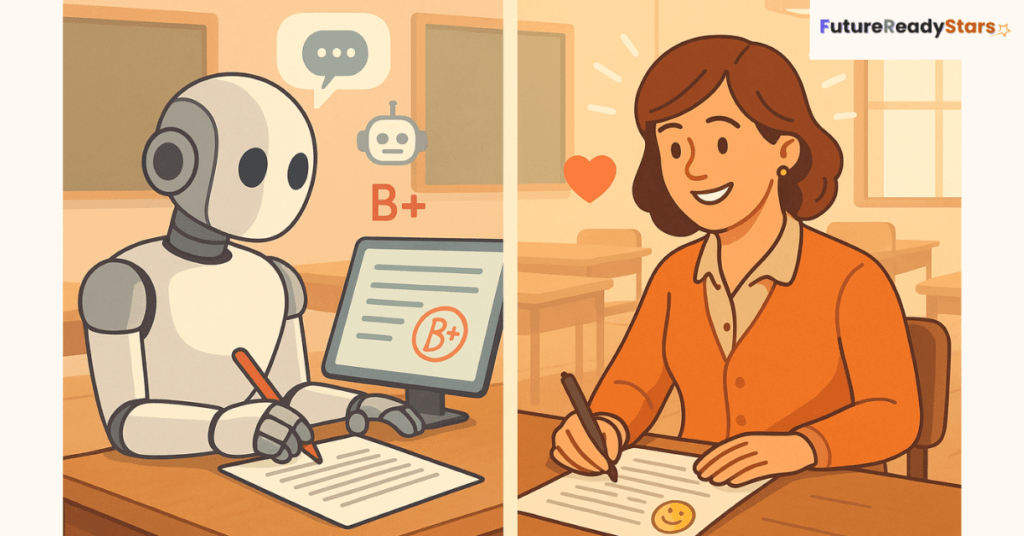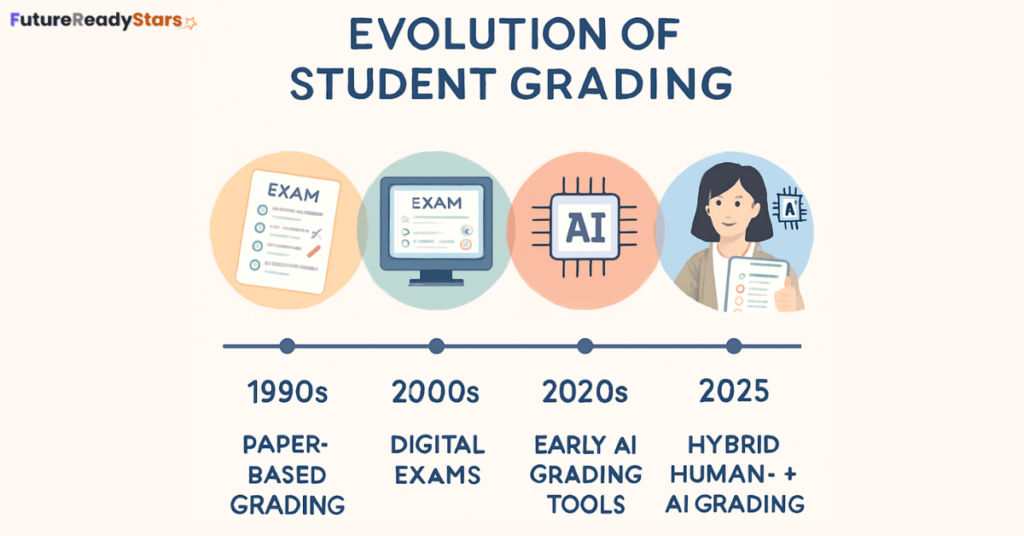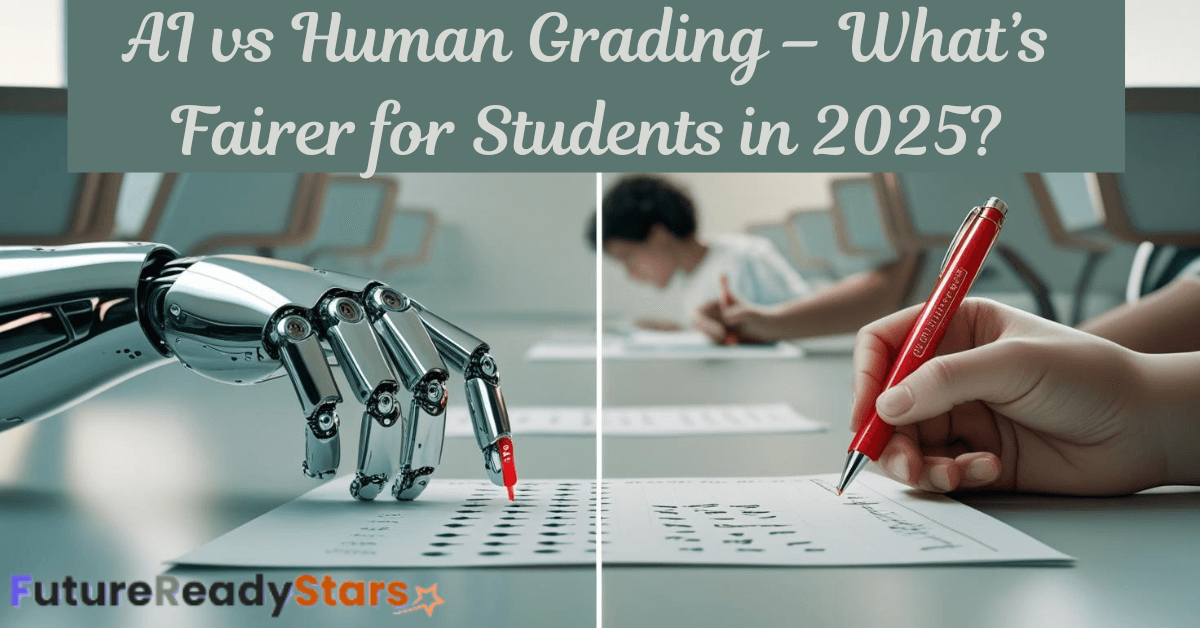In today’s classrooms, Artificial Intelligence is rapidly making its way into areas once considered purely human-driven. One major shift is in how students are graded. But as AI tools become more common, a big question arises: Can AI really grade students more fairly than human teachers? Or are there key elements of human judgment that machines still can’t replace?
Also Read: How I Built a No-Code AI Chatbot for CBSE & US EducationWhat Is AI Grading?

AI grading refers to using computer programs to help check and score student work. These systems use tools like machine learning and natural language processing to understand what a student wrote.
For example, AI can:
- Grade multiple-choice or short-answer questions
- Check essays for grammar and structure
- Give quick feedback on writing
Tools like Gradescope, Turnitin, and Grammarly already help teachers save time. Some even try to match how a teacher might grade, at least for basic tasks.
But while AI is fast and consistent, it still doesn’t understand things like tone, creativity, or a student’s intent the way a human can.
Also Read: Top 10 AI Tools That Predict Exam Questions (2025’s Secret Weapon)Why Are Schools Turning to AI Grading?

Schools in the U.S. are facing a tough mix of problems. Many classrooms have too many students, and not enough teachers. Plus, grading takes a lot of time—time that teachers often don’t have.
Because of this, some schools are using AI to help. It’s fast, doesn’t get tired, and can score student work the same way every time. That consistency can be a big help when you’re managing large workloads.
The goal is to free teachers from repetitive grading so they can focus more on teaching and supporting students. According to the U.S. Department of Education, AI can be a supportive tool when used responsibly.
Also Read: Top 20 ‘No Internet Needed’ AI Tools Bridging the Digital Divide in 2025The Pros of AI Grading in Education
1. Speed and Efficiency
AI tools can process hundreds of assignments in minutes. This helps teachers return feedback quickly and identify students who need support earlier.
2. Reduced Bias
Unlike humans, AI doesn’t hold personal opinions or unconscious biases. Ideally, this means every student is judged by the same standard.
3. Scalability
AI systems can handle large volumes of grading, which is useful in standardized testing or online courses with thousands of learners.
But is AI always fair?
Despite these clear advantages, AI grading isn’t perfect—and several educators are raising valid concerns.
1. Limited Understanding of Context
AI struggles to understand creative expression, humor, or cultural references. For example, a student might use slang or regional language that an algorithm flags as incorrect, even if it makes sense in context.
2. Over-Reliance on Grammar and Structure
Many AI systems focus heavily on surface-level writing issues—grammar, spelling, and sentence structure. This can overlook deeper qualities like critical thinking, originality, or empathy.
3. Algorithmic Bias
While AI aims to remove bias, it can still reflect the biases in the data it was trained on. If training data favored certain writing styles or dialects, students outside that norm may be unfairly penalized. MIT Technology Review explored this in depth.
“AI should be treated as a teaching assistant, not a teacher. It’s great at catching surface-level errors and speeding up grading, but it lacks the emotional intelligence and context-awareness that students need from educators.” — Dr. Melissa Grant, Education Technology Specialist, University of California
Also Read: ChatGPT for Students: How to Use AI Ethically in School (2025 Guide)Human Grading: Still Important?
While AI is fast, only teachers can read between the lines and connect with student intent.
Teachers bring life experience, emotional understanding, and subject expertise to grading. They can recognize when a student is trying something new, showing effort, or expressing a unique idea—even if the execution isn’t perfect.
Here’s what human grading still does better:
- Understanding Intent: A teacher can spot when a student is trying something bold, even if it’s not perfectly executed.
- Cultural Sensitivity: Humans can recognize diverse ways of expressing ideas and adjust feedback accordingly.
- Mentorship: Feedback from a teacher can include encouragement and personal notes that motivate students.
Edutopia highlights how meaningful teacher feedback can build trust and learning.
Can AI and Teachers Work Together?
The most balanced approach may be a hybrid one:
The best approach might not be choosing between AI or teachers—it could be using both together. Think of it like this: AI can take care of the repetitive stuff, like checking grammar or scoring multiple-choice quizzes. This saves time and keeps things consistent.
Meanwhile, teachers can focus on what AI still can’t do well—like understanding a student’s thought process, creativity, or effort behind an answer. For example, if a student writes a personal story with a powerful message but a few grammar mistakes, a teacher can recognize the meaning and encourage the student’s effort. An AI might just flag the grammar issues and miss the bigger picture.
By working together, AI supports teachers instead of replacing them. It’s about giving teachers more time to teach and connect with students while still getting the grading done faster.
Real-World Case Study: When AI & Humans Worked Together
A New York high school piloted a blended grading system. The English teacher used AI to mark grammar and structure in rough drafts. The AI flagged common errors, saving hours of time. But the teacher still reviewed each essay for creativity and deeper meaning.
The result? Students received quicker feedback without losing the human connection.
In contrast, a Texas school tried AI-only grading for a writing assessment. Several essays written in African American Vernacular English (AAVE) received lower scores, even though the ideas were strong. This highlighted the importance of cultural awareness that AI lacks.
Also Read: AI and Teacher Collaboration: Redefining Modern ClassroomsFinal Thoughts: Who Should Grade?
A balanced view on fairness in grading.
Comparison Table: AI vs Human Grading
| Feature | AI Grading | Human Grading |
|---|---|---|
| Speed | ✅ Very fast | ❌ Time-consuming |
| Bias | ✅ Reduced (ideally)✅ | ❌ Can be biased |
| Context Understanding | ❌ Poor | ✅ Strong |
| Personal Feedback | ❌ Generic | ✅ Personalized & encouraging |
| Scalability | ✅ High | ❌ Low |
| Emotional Insight | ❌ None | ✅ Deep |
So, is AI grading fairer? In some ways, yes—especially when it comes to consistency and speed. But human grading offers depth, context, and care that machines can’t yet match.
In the end, fairness isn’t just about speed or accuracy—it’s about truly understanding students. AI can assist, but the heart of education still lies in human connection. Together, they could redefine how we measure learning in the future.
Not yet. AI can handle basic grading tasks like grammar checks or multiple-choice answers, but it still struggles with creativity, nuance, and context that human teachers understand better.
Yes, AI can reflect bias if it’s trained on biased data. For example, it may misinterpret regional dialects or cultural expressions if not properly designed and tested.
Yes, tools like Gradescope and Turnitin are already used in many schools to assist with grading. However, they are usually used alongside teacher evaluation, not in place of it.
It can. By automating repetitive grading tasks, AI gives teachers more time to focus on lesson planning, student support, and personal well-being.
Subjects like math, science, and grammar-based language tests are easier for AI to grade. Essays, creative writing, and critical thinking tasks still need human input.
Join the Conversation
What do you think? Would you trust an AI to grade your work—or your child’s? Share your thoughts in the comments or visit FutureReadyStars.com to learn more about AI in education.



